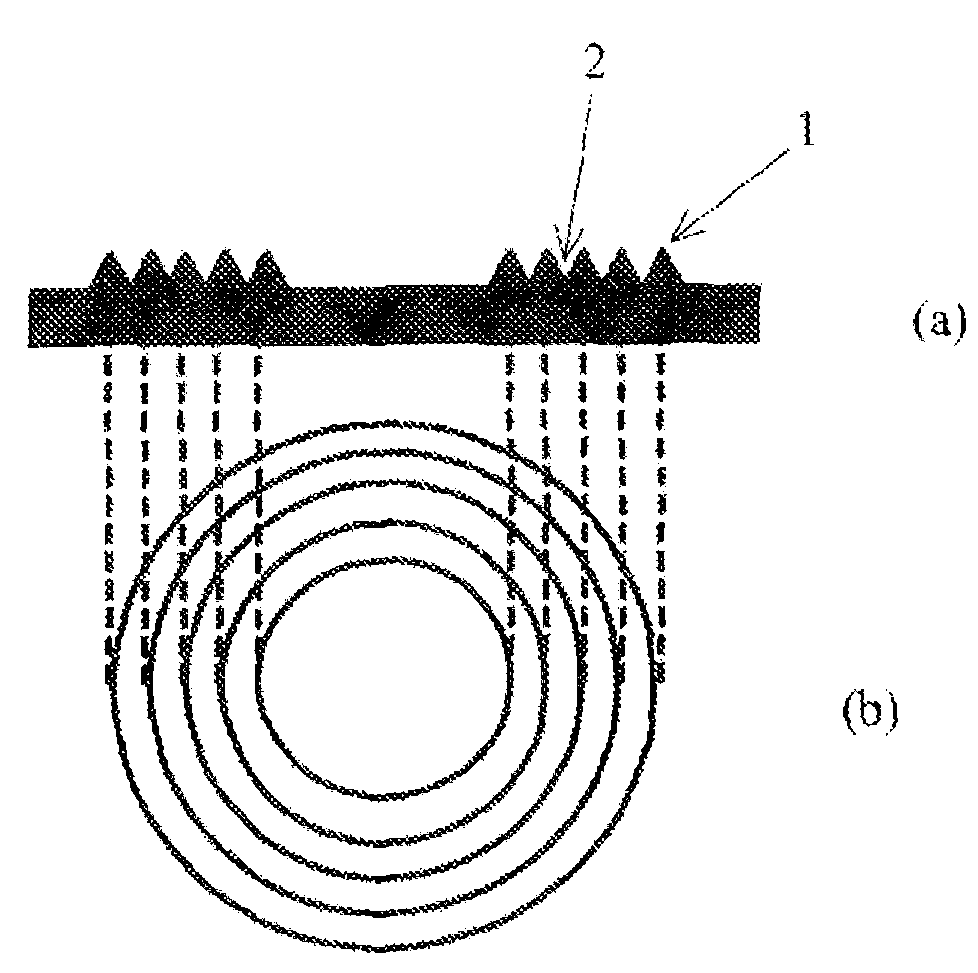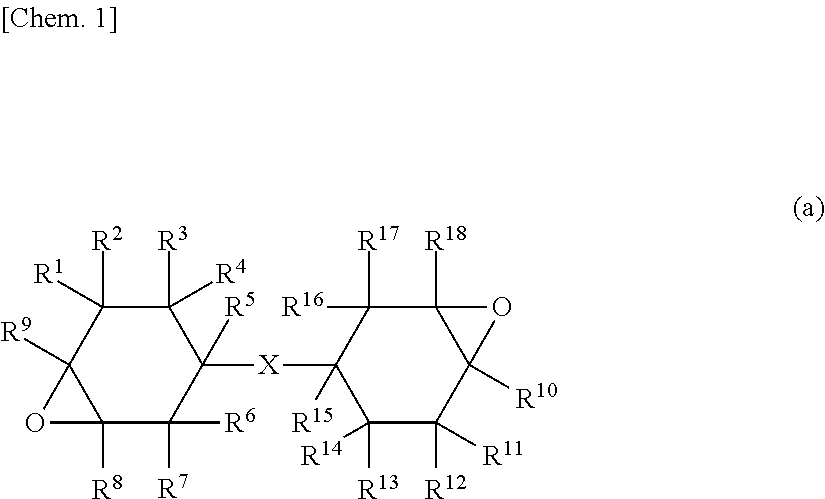Curable composition for lens, lens and optical device
a composition and lens technology, applied in the field of curable compositions, can solve the problems of difficult mold mold production, difficult mold production, and difficult mold production, and achieve the effects of improving curability, eliminating or minimizing the occurrence of “bubble entrapment”, and improving wettability with a mold
- Summary
- Abstract
- Description
- Claims
- Application Information
AI Technical Summary
Benefits of technology
Problems solved by technology
Method used
Image
Examples
preparation example 1
liphatic Epoxide (a-1)
[0199]A dehydration catalyst was prepared by mixing and stirring 70 g (0.68 mol) of 95% by weight sulfuric acid and 55 g (0.36 mol) of 1,8-diazabicyclo[5.4.0]undeconc-7 (DBU).
[0200]Into a 3-liter flask, 1000 g (5.05 mol) of hydrogenated biphenol (i.e., 4,4′-dihydroxybicyclohexyl), 125 g (0.68 mol in terms of sulfuric acid) of the above-prepared dehydration catalyst, and 1500 g of pseudocumene, followed by heating of the flask, where the flask was equipped with a stirrer, a thermometer, and a distillation pipe equipped with a dehydration tube and thermally insulated. Water production was observed around at the time point when the internal temperature exceeded 115° C. The temperature rise was continued up to the boiling point of pseudocumene (to an internal temperature of 162° C. to 170° C.), and a dehydration reaction was performed under normal atmospheric pressure. The by-produced water was distilled and discharged via the dehydration tube out of the system. Th...
preparation example 2
liphatic Epoxide (a-2)
[0202]Into a 5-L reactor, sodium hydroxide (granular) (499 g, 12.48 mol) and toluene (727 mL) were charged. After nitrogen purging, the resulting mixture was combined with a solution of tetrahydrobenzyl alcohol (420 g, 3.74 mol) in toluene (484 mL), followed by aging at 70° C. for 1.5 hours. Next, the mixture was further combined with tetrahydrobenzyl methanesulfonate (419 g, 2.20 mol), aged under reflux for 3 hours, cooled down to room temperature, and combined with water (1248 g) to quench the reaction. An organic layer was separated, concentrated, subjected to distillation under reduced pressure, and yielded ditetrahydrobenzyl ether as a colorless, transparent liquid in a yield of 85%. The prepared ditetrahydrobenzyl ether was subjected to 1H-NMR spectrum measurement.
[0203]1H-NMR (CDCl3): δ 1.23-1.33 (m, 2H), 1.68-1.94 (m, 6H), 2.02-2.15 (m, 6H), 3.26-3.34 (m, 4H), 5.63-7.70 (m, 4H)
[0204]The prepared ditetrahydrobenzyl ether (200 g, 0.97 mol), 20% SP-D (acet...
preparation example 3
liphatic Epoxide (a-3)
[0205]In a 1-liter jacketed flask equipped with a stirrer, a condenser, a thermometer, and a nitrogen inlet tube, 36 g of water, 12.0 g of sodium hydrogensulfate, 500 g of isopropylidene-4,4′-dicyclohexanol (supplied by Sigma-Aldrich), and 500 g of Solvesso 150 (supplied by Exxon Mobile Corporation) as a solvent were placed, followed by a dehydration reaction at 100° C. The reaction was completed at the time point when water was ceased to be distilled. The reaction mixture was analyzed by gas chromatography to find that 2,2-bis(3-cyclohexen-1-yl)propane was formed in a yield of 96%. The reaction mixture was washed with 500 ml of ion-exchanged water using a separatory funnel, of which the organic layer was subjected to distillation under reduced pressure, and yielded 387.0 g of 2,2-bis(3-cyclohexen-1-yl)propane as a colorless, transparent liquid with a purity of 96.1%.
[0206]Into a 1-liter jacketed flask as above, 100 g of the prepared 2,2-bis(3-cyclohexen-1-yl)p...
PUM
| Property | Measurement | Unit |
|---|---|---|
| diameter | aaaaa | aaaaa |
| diameter | aaaaa | aaaaa |
| temperature | aaaaa | aaaaa |
Abstract
Description
Claims
Application Information
 Login to View More
Login to View More - R&D
- Intellectual Property
- Life Sciences
- Materials
- Tech Scout
- Unparalleled Data Quality
- Higher Quality Content
- 60% Fewer Hallucinations
Browse by: Latest US Patents, China's latest patents, Technical Efficacy Thesaurus, Application Domain, Technology Topic, Popular Technical Reports.
© 2025 PatSnap. All rights reserved.Legal|Privacy policy|Modern Slavery Act Transparency Statement|Sitemap|About US| Contact US: help@patsnap.com



